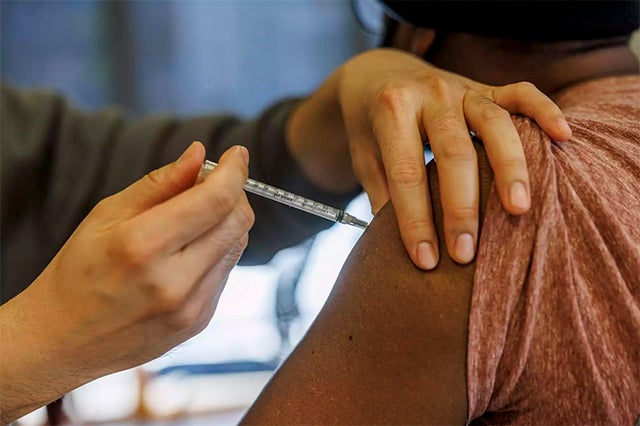Only 1 percent of Minnesotans ages 65 or older are up to date on COVID vaccine
Published 5:53 pm Friday, March 22, 2024

- An M Health Fairview nurse gives a COVID-19 vaccination at Brian Coyle Center in M Health Fairview in Minneapolis on Jan. 6. Kerem Yücel/MPR News 2023
|
Getting your Trinity Audio player ready...
|
By Craig Helmstetter, Minnesota Public Radio News
Snow fell on Thursday, and so did Minnesota’s COVID-19 vaccination rate.
The monthly vaccination rate data released Thursday by the Minnesota Department of Health show only 12.5 percent of Minnesotans, including only 1 percent of those age 65 or older, are up to date on their COVID vaccines. This is down from the 21 percent up-to-date rate, including over 58 percent among the older adult crowd, released last month.
It is not that Minnesotans are somehow becoming unvaccinated. It is just that the department’s latest vaccination rate data now considers the Centers for Disease Control and Prevention’s (CDC) latest guidance on vaccination, issued on Feb. 28, recommending all adults ages 65 and older receive an additional dose of the version of the COVID-19 vaccine released early last fall.
The definition of “up to date” did not change for those younger than 65, and vaccination rates improved for that large age group — but by less than one percentage point. Demand for the new version of COVID-19 vaccine continues to be tepid with less than 15 percent of any age group below age 50 in Minnesota receiving the shot to date.
According to the health department’s new data, only 8,407 Minnesotans ages 65 or older had gotten their second dose of the new vaccine as of March 16.
The effectiveness of the COVID-19 vaccination in protecting against severe illness and even death wanes over time. While fewer people are dying from COVID-19 than in the first three years of the pandemic, the state has reported 331 deaths at least partially due to COVID-19 so far in 2024, 308 of which have been among those ages 65 and older.
Hospitalizations due to COVID-19 continue to trend downward, now for the ninth consecutive week. The amount of COVID-19 measured in the state’s wastewater is also down by 20 percent in the most recent weekly comparison. According to data from the University of Minnesota’s ongoing Wastewater Surveillance Study, levels are down in all but two regions of the state, Southwest and Northeast. Levels are also down in those regions looking back four weeks.
Hospital admissions due to respiratory syncytial virus (RSV) are also down again in the most recent week’s data, but hospitalizations due to influenza ticked up again. Two hundred and six Minnesotans were admitted to the hospital with the flu during the latest week with complete data (ending March 2), nearly matching this season’s high of 297 admissions during Christmas week.
While measles cases continue to pop up in other parts of the country, the Minnesota Department of Health has not reported any new cases in the state for the past month.
Long COVID updates
According to self-reported data collected through the U.S. Census Bureau’s Household Pulse survey, 15 percent of Minnesota adults indicate they have experienced long COVID at some point in the past four years, including the six percent who are currently experiencing long COVID. Minnesota’s rates are just slightly lower than those reported nationally.
Medical treatment for long COVID remains unclear, so the National Institutes of Health (NIH) generated some excitement last week by announcing the launch of two new clinical trials as a part of its larger on-going long COVID program dubbed RECOVER.
These trials specifically address post-COVID adults with postural orthostatic tachycardia (POTS), which is characterized by commonly experiencing “unexpected fast heart rate, dizziness, fatigue or a combination of these symptoms when a person stands up from sitting or lying down.”
Together, these new trials will examine three treatments: an antibody-containing infusion (Gamunex-C), a heart-rate reducing medicine (Ivabradine), and “coordinator-guided, non-drug care, which includes a series of activities managed through weekly phone calls with a care coordinator, such as wearing a compression belt and eating a high-salt diet, which are recommended for patients with POTS to counteract excessive loss of fluids.”
Researchers are currently enrolling patients so results will not be available for some time. Along with other ongoing research in the area, these new studies provide some glimmer of hope for those coping with long COVID.



